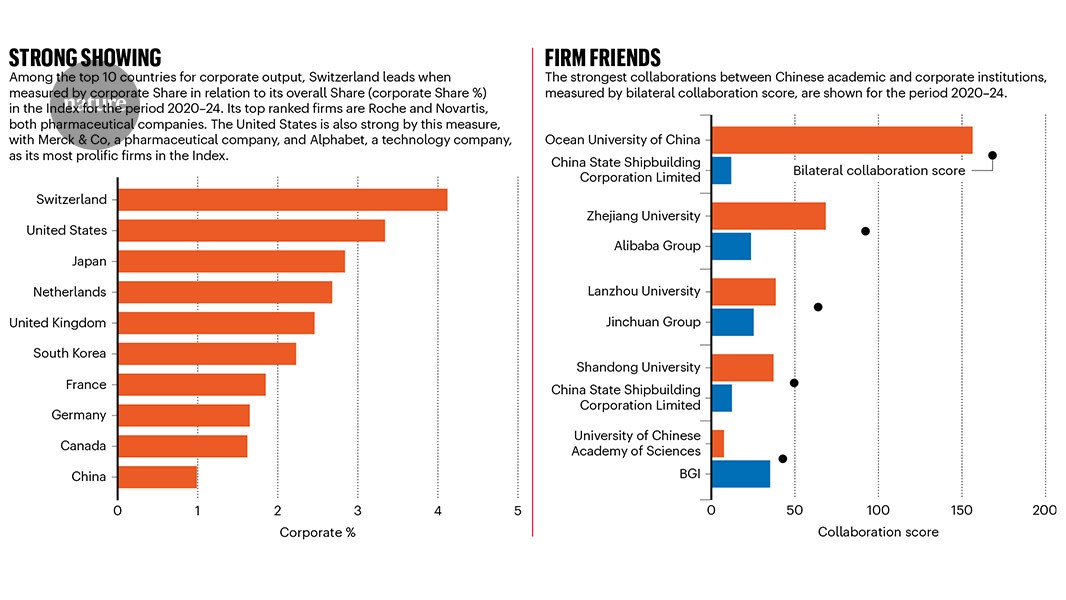An increasing number of Chinese companies are grabbing the headlines with new technologies rolled out at scale. The most prominent example in 2025 has been DeepSeek and its low-cost large language models, but others include electric-vehicle (EV) maker BYD — which this year launched its ‘God’s Eye’ intelligent driving system as a standard feature on most of its models — and battery manufacturer CATL, which is planning a major expansion of ‘swapping stations’ in China that allow quick battery replacement in EVs.
Nature Index 2025 Science Inc.
Underlying such roll-outs is a commitment to research and development and an increasing synergy between China’s top universities and its private sector. In many ways, collaboration between academia and industry in China, especially when it comes to launching new companies and products, is similar to how things work in the West. It is increasingly structured around a high-risk, high-reward funding philosophy in which promising ideas originating in academia are given investment, even if the vast majority of them fail. But unlike well-established university–industry ecosystems such as Silicon Valley, where private investors typically dominate and accept the risk of most start-up businesses failing, in China, the state plays a pivotal role. National government departments, including the Ministry of Science and Technology (MOST), and local innovation funds are pouring billions of yuan into university-affiliated businesses, knowing most will not achieve commercial success. However, those that do can go on to redefine whole industries.
Chinese policy has explicitly sought to create synergies between researchers and companies since the launch of a MOST initiative in 1988 called the Torch Programme. It sought to commercialize research outputs from universities and institutes and set up special research zones — such as Zhongguancun in Beijing — that provide incentives for start-ups such as tax breaks, easier access to credit, land and infrastructure. This was followed in 2014 by the Mass Innovation and Entrepreneurship plan, which sought to spark grassroots innovation and start-up activity across China — not just in elite labs or giant companies, but among ordinary citizens, students, small firms and rural entrepreneurs. The plan has funded innovation spaces and incubators, and expanded access to venture capital, angel funding and government support. It also explicitly encouraged universities to spin off research into new companies, with scientists taking equity stakes in the firms.
As well as schemes to boost funding, the government can act as facilitator, reducing bureaucratic hurdles to accelerate lab-to-market transitions. One example is China’s National Medical Products Administration, formerly the China Food and Drug Administration, which has undergone major reforms in the past decade to speed up drug approvals and clinical trials. A priority review pathway was established for especially promising medicines; China joined the International Council for Harmonisation of Technical Requirements for Pharmaceuticals for Human Use in 2017 so that Chinese clinical trials would be accepted in other countries and cut backlogs of clinical-trial applications, partly through digitalized submission systems and more staff.
The Chinese model is evident in companies such as Beijing-based Likang Life Sciences, an mRNA cancer vaccine start-up with links to Tsinghua University, also based in China’s capital. Likang is making use of Tsinghua’s pool of researchers by jointly establishing an AI for Medicine laboratory to promote an mRNA vaccine that can be tailored to individual patients using genetic sequencing.
Although its vaccine technology is still in early clinical trials, Likang represents the ambition of the country’s health innovation system. Yet the challenges are immense. Cancer vaccines using mRNA technology are still unproven at scale, and Likang is competing with well-known global companies such as Moderna in Boston, Massachusetts, and BioNTech in Mainz, Germany. But the rewards for Chinese policymakers, who see biotechnology as a strategic priority, are potentially huge. If only one such company succeeds, it could position China as a leader in precision medicine.
Another example of China’s approach is the Sunway TaihuLight supercomputer based in Wuxi, which was developed with public money by the National Research Center of Parallel Computer Engineering & Technology with close involvement from Tsinghua University. Rather than being used purely for academic computation, the supercomputer has been used by private Chinese companies in domains such as weather forecasting, materials simulation and drug discovery. Unlike Western supercomputers, which often rely on corporate partnerships to be built before they are then made available to researchers, China’s approach is seeking to integrate academic research with state-backed industrial policy. The project’s success has spurred further partnerships with companies, including in artificial intelligence (AI) and quantum computing.
The possibilities of AI in education, a hot topic in China, provides a different template for the Chinese innovation model. Researchers in machine learning and cognitive science have spun off companies such as Liulishuo, an AI language tutor, and Squirrel AI, which adapts lessons to an individual student’s needs. Such start-ups are often founded using grants from the National Natural Science Foundation of China, then attract private capital.



